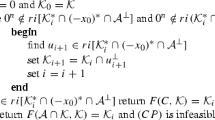Abstract
Historically, much of the theory and practice in nonlinear optimization has revolved around the quadratic models. Though quadratic functions are nonlinear polynomials, they are well structured and many of them are found easy to deal with. Limitations of the quadratics, however, become increasingly binding as higher-degree nonlinearity is imperative in modern applications of optimization. In recent years, one observes a surge of research activities in polynomial optimization, and modeling with quartic or higher-degree polynomial functions has been more commonly accepted. On the theoretical side, there are also major recent progresses on polynomial functions and optimization. For instance, Ahmadi et al. (Math Program Ser A 137:453–476, 2013) proved that checking the convexity of a quartic polynomial is strongly NP-hard in general, which settles a long-standing open question. In this paper, we proceed to study six fundamentally important convex cones of quartic forms in the space of super-symmetric tensors, including the cone of nonnegative quartic forms, the sums of squared forms, the convex quartic forms, and the sums of fourth-power forms. It turns out that these convex cones coagulate into a chain in a decreasing order with varying complexity status. Potential applications of these results to solve highly nonlinear and/or combinatorial optimization problems are discussed.

Similar content being viewed by others
References
A.A. Ahmadi, G. Blekherman, P.A. Parrilo, Convex Ternary Quartics Are SOS-Convex, Preprint, Department of Electrical Engineering and Computer Science, Massachusetts Institute of Technology, Cambridge (2011)
A.A. Ahmadi, A. Olshevsky, P.A. Parrilo, J.N. Tsitsiklis, NP-Hardness of Deciding Convexity of Quartic Polynomials and Related Problems, Mathematical Programming, Series A, 137, 453–476 (2013)
A.A. Ahmadi, P.A. Parrilo, A Convex Polynomial That Is Not SOS-Convex, Mathematical Programming, Series A, 135, 275–292 (2012)
A.A. Ahmadi, P.A. Parrilo, A Complete Characterization of the Gap between Convexity and SOS-Convexity, SIAM Journal on Optimization, 23, 811–833 (2013)
A. Barvinok, A Course in Convexity, Graduate Studies in Mathematics, Volume 54, American Mathematical Society, Providence (2002)
P. Biswas, T.-C. Liang, T.-C. Wang, Y. Ye, Semidefinite Programming Based Algorithms for Sensor Network Localization, ACM Transactions on Sensor Networks, 2, 188–220 (2006)
G. Blekherman, Convex Forms That Are Not Sums of Squares, Preprint (2009) http://arxiv.org/abs/0910.0656
S. Burer, On the Copositive Representation of Binary and Continuous Nonconvex Quadratic Programs, Mathematical Programming, Series A, 120, 479–495 (2009)
S. Burer, H. Dong, Representing Quadratically Constrained Quadratic Programs as Generalized Copositive Programs, Operations Research Letters, 40, 203–206 (2012)
R.E. Burkard, E. Cela, Heuristis for Biqudratic Assignment Problems and Their Computational Comparison, European Journal of Operational Research, 83, 283–300 (1995)
R.E. Burkard, E. Cela, B. Klinz, On the Biquadratic Assignment Problem, Quadratic Assignment and Related Problems (P.M. Pardalos, H. Wolkowicz, eds.), DIMACS Series in Discrete Mathematics and Theoretical Computer Science, 16, 117–146, American Mathematical Society, Providence (1994)
C. Chen, P.P. Vaidyanathan, MIMO Radar Waveform Optimization with Prior Information of the Extended Target and Clutter, IEEE Transactions on Signal Processing, 57, 3533–3544 (2009)
E.C. Chi, T.G. Kolda, On Tensors, Sparsity and Nonnegative Factorizations, SIAM Journal on Matrix Analysis and Applications, 33, 1272–1299 (2012)
M.D. Choi, T.Y. Lam, An Old Question of Hilbert, Queen’s Papers in Pure and Applied Mathematics, 46, 385–405 (1977)
M.D. Choi, T.Y. Lam, Extremal Positive Semidefinite Forms, Mathematische Annalen, 231, 1–18 (1977)
G. Dahl, J.M. Leinaas, J. Myrheim, E. Ovrum, A Tensor Product Matrix Approximation Problem in Quantum Physics, Linear Algebra and its Applications, 420, 711–725 (2007)
P.J.C. Dickinson, L. Gijben, On the Computational Complexity of Membership Problems for the Completely Positive Cone and Its Dual, Computational Optimization and Applications, 57, 403–415 (2014)
V.I. Dmitriev, The Structure of a Cone in a Five-Dimensional Space (Russian), Vorone. Gos. Univ. Trudy Naun.-Issled. Inst. Mat. VGU Vyp., 7, 13–22 (1973)
S. He, Z. Li, S. Zhang, Approximation Algorithms for Homogeneous Polynomial Optimization with Quadratic Constraints, Mathematical Programming, Series B, 125, 353–383 (2010)
S. He, Z. Li, S. Zhang, Inhomogeneous Polynomial Optimization Over a Convex Set: An Approximation Approach, Mathematics of Computation, 84, 715–741 (2015)
J.W. Helton, J. Nie, Semidefinite Representation of Convex Sets, Mathematical Programming, Series A, 122, 21–64 (2010)
D. Hilbert, Über die Darstellung Definiter Formen als Summe von Formenquadraten, Mathematische Annalen, 32, 342–350 (1888)
C.J. Hillar, L.-H. Lim, Most Tensor Problems Are NP-Hard, Journal of the ACM, 60, Article 45 (2013)
R.A. Horn, C.R. Johnson, Matrix Analysis, Cambridge University Press, Cambridge (1995)
B. Jiang, S. He, Z. Li, S. Zhang, Moments Tensors, Hilbert’s Identity, and k-wise Uncorrelated Random Variables, Mathematics of Operations Research, 39, 775–788 (2014)
B. Jiang, S. Ma, S. Zhang, Tensor Principal Component Analysis via Convex Optimization, Mathematical Programming, Series A, 150, 423–457 (2015)
P.M. Kleniati, P. Parpas, B. Rustem, Partitioning Procedure for Polynomial Optimization: Application to Portfolio Decisions with Higher Order Moments, COMISEF Working Papers Series, WPS-023 (2009)
J.B. Lasserre, Global Optimization with Polynomials and the Problem of Moments, SIAM Journal on Optimization, 11, 769–817 (2001)
M. Laurent, Sums of Squares, Moment Matrices and Optimization over Polynomials, Emerging Applications of Algebraic Geometry (M. Putinar, S. Sullivant, eds.), The IMA Volumes in Mathematics and Its Applications, Volumn 149, Springer, Berlin (2009)
B. Lenore, F. Cucker, M. Shub, S. Smale, Complexity and Real Computation, Springer, New York (1997)
Z. Li, S. He, S. Zhang, Approximation Methods for Polynomial Optimization: Models, Algorithms, and Applications, SpringerBriefs in Optimization, Springer, New York (2012)
L.-H. Lim, Singular Values and Eigenvalues of Tensors: A Variational Approach, Proceedings of the IEEE International Workshop on Computational Advances in Multi-Sensor Adaptive Processing, 1, 129–132 (2005)
L.-H. Lim, M. Ng, L. Qi, eds., The Spectral Theory of Tensors and Its Applications, Numerical Linear Algebra with Applications, 20, Issue 6, (2013)
C. Ling, J. Nie, L. Qi, Y. Ye, Biquadratic Optimization Over Unit Spheres and Semidefinite Programming Relaxations, SIAM Journal on Optimization, 20, 1286–1310 (2009)
Z.-Q. Luo, J.F. Sturm, S. Zhang, Multivariate Nonnegative Quadratic Mappings, SIAM Journal on Optimization, 14, 1140–1162 (2004)
Z.-Q. Luo, S. Zhang, A Semidefinite Relaxation Scheme for Multivariate Quartic Polynomial Optimization With Quadratic Constraints, SIAM Journal on Optimization, 20, 1716–1736 (2010)
T. Mavridou, P.M. Pardalos, L.S. Pitsoulis, M.G.C. Resende, A GRASP for the Biquadratic Assignment Problem, European Journal of Operational Research, 105, 613–621 (1998)
J. Nie, The \({\cal A}\) -Truncated K-Moment Problem, Foundations of Computational Mathematics, 14, 1243–1276 (2014)
P.M. Pardalos, S.A. Vavasis, Open Questions in Complexity Theory for Numerical Optimization, Mathematical Programming, 57, 337–339 (1992)
P.A. Parrilo, Structured Semidefinite Programs and Semialgebraic Geometry Methods in Robustness and Optimization, Ph.D. Dissertation, California Institute of Technology, Pasadena (2000)
L. Qi, Eigenvalues of a Real Supersymmetric Tensor, Journal of Symbolic Computation, 40, 1302–1324 (2005)
L. Qi, F. Wang, Y. Wang, Z-eigenvalue Methods for a Global Polynomial Optimization Problem, Mathematical Programming, Series A, 118, 301–316 (2009)
S. Ragnarsson, C.F. Van Loan, Block Tensors and Symmetric Embeddings, Linear Algebra and its Applications, 438, 853–874 (2013)
B. Reznick, Banach Spaces with Polynomial Norms, Pacific Journal of Mathematics, 82, 223–235 (1979)
B. Reznick, Sums of Even Powers of Real Linear Forms, Memoirs of the American Mathematical Society, Volume 96, Number 463, American Mathematical Society, Providence (1992)
B. Reznick, Some Concrete Aspects of Hilbert’s 17th Problem, Real Algebraic Geometry and Ordered Structures, Contemporary Mathematics, Volume 253, American Mathematical Society, Providence (2000)
B. Reznick, Blenders, Notions of Positivity and the Geometry of Polynomials (P. Brändén, M. Passare, M. Putinar, eds.), Trends in Mathematics, 345–373, Springer, Basel (2011)
R.M. Robinson, Some Definite Polynomials Which Are Not Sums of Squares of Real Polynomials (Russian), Selected Questions of Algebra and Logic, 264–282, Academy of Sciences USSR, Novosibirsk (1973)
A.M.-C. So, Deterministic Approximation Algorithms for Sphere Constrained Homogeneous Polynomial Optimization Problems, Mathematical Programming, Series B, 129, 357–382 (2011)
J.F. Sturm, S. Zhang, On Cones of Nonnegative Quadratic Functions, Mathematics of Operations Research, 28, 246–267 (2003)
S. Zhang, Z. Li, S. Ma, eds., Special Issue on Polynomial and Tensor Optimization, Pacific Journal of Optimization, Volume 11, Number 2, (2015)
Acknowledgments
We would like to thank three anonymous referees for their insightful comments, which helped significantly improve this paper from its original version. This work was partially supported by National Science Foundation of China (Grants 11401364 and 11371242) and the US National Science Foundation (Grant CMMI-1161242).
Author information
Authors and Affiliations
Corresponding author
Additional information
Communicated by Michael Jeremy Todd.
Appendix: Proof of Theorem 6.1
Appendix: Proof of Theorem 6.1
Here we only prove the equivalent relation for the maximization problems since the proof for their minimization counterparts is exactly the same. That is, we shall prove the equivalence between (Q) and (RQ).
To start with, let us first investigate the feasible regions of these two problems, to be denoted by \(\mathrm{feas}\,(Q)\) and \(\mathrm{feas}\,(RQ)\), respectively. The relationship between \(\mathrm{feas}\,(Q)\) and \(\mathrm{feas}\,(RQ)\) is revealed by the following lemma.
Lemma 6.4
It holds that \(\mathrm{conv}\left( \mathrm{feas}\,(Q)\right) \subseteq \mathrm{feas}\,(RQ) = \mathrm{conv}\left( \mathrm{feas}\,(Q)\right) +\mathbf {P}\), where
Proof
First, it is obvious that \(\mathrm{conv}\left( \mathrm{feas}\,(Q)\right) \subseteq \mathrm{feas}\,(RQ)\) as (RQ) is a relaxation of (Q) and \(\mathrm{feas}\,(RQ)\) is convex. Next, we notice that the recession cone of \(\mathrm{feas}\,(RQ)\) is equal to
Observing that \(\bar{\mathcal {X}}\in {\varvec{\Sigma }}_{n+1,4}^4\) and \(\mathcal {X}_{n+1,n+1,n+1,n+1}=0\), it is easy to see that \(x=0\) and \(X=0\). Thus, the recession cone of \(\mathrm{feas}\,(RQ)\) is reduced to
which proves \(\mathrm{feas}\,(RQ) \supseteq \mathrm{conv}\left( \mathrm{feas}\,(Q)\right) +\mathbf {P}\).
Finally, we shall show the inverse inclusion, i.e., \(\mathrm{feas}\,(RQ) \subseteq \mathrm{conv}\left( \mathrm{feas}\,(Q)\right) +\mathbf {P}\). Suppose \(\bar{\mathcal {X}}\in \mathrm{feas}\,(RQ)\), and it can be decomposed as
where \(\alpha _k\in {\mathbf {R}}\), \(y^k\in {\mathbf {R}}^n\) for all \(k\in K\). Immediately we have
Now divide the index set K into two parts \(K_0:=\{k\in K\mid \alpha _k=0\}\) and \(K_1:=\{ k\in K\mid \alpha _k\ne 0 \}\), and let \(z^k=y^k/\alpha _k\) for all \(k\in K_1\). The decomposition (25) is then equivalent to
If we can prove that
then by (26), we shall have \(\bar{\mathcal {X}}\in \mathrm{conv}\left( \mathrm{feas}\,(Q)\right) +\mathbf {P}\), proving the inverse inclusion.
In the following, we shall prove (27) and (28). Since \(\bar{\mathcal {X}}\in \mathrm{feas}\,(RQ)\), together with \(x=\sum _{k\in K}{\alpha _k}^3y^k\), \(X=\sum _{k\in K}{\alpha _k}^2y^k\otimes y^k\) and \(\mathcal {X}=\sum _{k\in K}y^k\otimes y^k\otimes y^k\otimes y^k\), we obtain the following equalities:
As a direct consequence of the above equalities and (26), we have
Noticing that the equalities hold for the above Cauchy–Schwarz inequalities, it follows that for every \(1\le i \le m\) and every \(1\le j \le l\), there exist \(\delta _i, \epsilon _i, \theta _j\in {\mathbf {R}}\), such that
If \(\alpha _k=0\), then \((a^i)^{\mathrm{T}}y^k=0\) and \((y^k)^{\mathrm{T}}A^jy^k=0\), which implies (28). Moreover, due to (29) and (26),
Similarly, we have \(\theta _j = c_j\) for all \(1\le j \le l\). If \(\alpha _k\ne 0\), noticing \(z^k=y^k/\alpha _k\), it follows from (29) that
which implies (27). \(\square \)
To prove Theorem 6.1, we notice that if \(A^j\) is positive semidefinite, then
Therefore, \(\left( {\begin{array}{c}x\\ 0\end{array}}\right) \otimes \left( {\begin{array}{c}x\\ 0\end{array}}\right) \otimes \left( {\begin{array}{c}x\\ 0\end{array}}\right) \otimes \left( {\begin{array}{c}x\\ 0\end{array}}\right) \in \mathbf {P}\) implies that x is a recession direction of the feasible region for (P). Applying this property and using a similar argument of Theorem 2.6 in [8], Theorem 6.1 follows immediately.
Rights and permissions
About this article
Cite this article
Jiang, B., Li, Z. & Zhang, S. On Cones of Nonnegative Quartic Forms. Found Comput Math 17, 161–197 (2017). https://doi.org/10.1007/s10208-015-9286-4
Received:
Revised:
Accepted:
Published:
Issue Date:
DOI: https://doi.org/10.1007/s10208-015-9286-4
Keywords
- Cone of polynomial functions
- Super-symmetric tensors
- Nonnegative quartic forms
- Sums of squares
- SOS-convexity
- Polynomial optimization



